Congo Bongo
 The Game: You’re a jungle explorer hot on the trail of Bongo the Ape. The first level in your quest is a hazardous assortment of ramps and levels and a waterfall to jump across. Be careful of pesky little monkeys who can weigh you down so you move slower (and jump lower). And watch out for snakes. Then you have to hop across a river using lily pads, the backs of hippos, and other floating objects – just try not to miss! (Sega, 1983)
The Game: You’re a jungle explorer hot on the trail of Bongo the Ape. The first level in your quest is a hazardous assortment of ramps and levels and a waterfall to jump across. Be careful of pesky little monkeys who can weigh you down so you move slower (and jump lower). And watch out for snakes. Then you have to hop across a river using lily pads, the backs of hippos, and other floating objects – just try not to miss! (Sega, 1983)
Memories: Egads. Didn’t Sega learn the lesson from Coleco’s horrid VCS version of Zaxxon? Guess not, because their in-house attempt to translate the equally elaborate Congo Bongo arcade game for the 2600, while a bit less of a graphical and game play train wreck than Zaxxon, is still a train wreck.
Congo Bongo
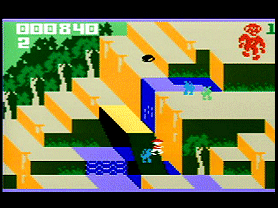 The Game: Bongo the ape sets your toes on fire while you’re asleep during a jungle expedition. So naturally, you drop everything to take revenge on the goofy gorilla…but first you have to traverse craggy outcroppings, cross treacherous bridges, hop across a river on the backs of hippos, duck the attacks of charging rhinos, all to set Bongo’s toes on fire as he sleeps… and then the whole thing starts again. (Sega, 1983)
The Game: Bongo the ape sets your toes on fire while you’re asleep during a jungle expedition. So naturally, you drop everything to take revenge on the goofy gorilla…but first you have to traverse craggy outcroppings, cross treacherous bridges, hop across a river on the backs of hippos, duck the attacks of charging rhinos, all to set Bongo’s toes on fire as he sleeps… and then the whole thing starts again. (Sega, 1983)
Memories: Possibly the single rarest Intellivision game that doesn’t require extra gear such as the ECS computer keyboard, Congo Bongo was Sega‘s singular foray into providing home versions of its arcade titles for Intellivision players. Sega had already been collaborating with Coleco for some time, but had recently gone it alone with Atari 2600 and 5200 editions of such games as Star Trek: Strategic Operations Simulator and Congo Bongo. If Sega had a single problem with its early attempts as a software publisher in the American market, it was timing: most of its games arrived just as the video game industry crash was forcing retailers into a no-win scenario of price cuts and losses.
Congo Bongo
 The Game: Bongo the Ape sets your toes on fire while you’re asleep during a jungle expedition. So naturally, you drop everything to take revenge on the goofy gorilla. But first you have to reach him. The first level is a hazardous assortment of ramps and levels and a waterfall to jump across. Be careful of pesky little monkeys who can weigh you down so you move slower (and jump lower), and watch out for snakes. Then you have to hop across various islands and dodge more snakes as you try to get across a river. (Sega, 1983)
The Game: Bongo the Ape sets your toes on fire while you’re asleep during a jungle expedition. So naturally, you drop everything to take revenge on the goofy gorilla. But first you have to reach him. The first level is a hazardous assortment of ramps and levels and a waterfall to jump across. Be careful of pesky little monkeys who can weigh you down so you move slower (and jump lower), and watch out for snakes. Then you have to hop across various islands and dodge more snakes as you try to get across a river. (Sega, 1983)
Memories: What an utterly strange gaming experience this is on the 5200. The system is much better equipped to handle this game than its older and less capable brother, and yet it still falls strangely flat. A big part of the problem is motion.
Chase The Chuckwagon
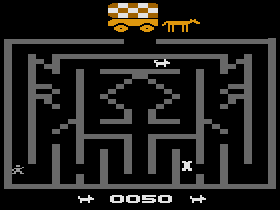 The Game: You control a dog trapped in a maze. Find your way out of the maze without being snared by a dogcatcher, and work your way toward the PurinaTM ChuckwagonTM for some kibbles ‘n’ bits. Chasing the Chuckwagon is only part of the fun, though, for then you have to time things just right to help the dog eat. (Ralston Purina Corp., 1983)
The Game: You control a dog trapped in a maze. Find your way out of the maze without being snared by a dogcatcher, and work your way toward the PurinaTM ChuckwagonTM for some kibbles ‘n’ bits. Chasing the Chuckwagon is only part of the fun, though, for then you have to time things just right to help the dog eat. (Ralston Purina Corp., 1983)
Memories: Long considered a must-have in the game library of any hardcore Atari 2600 collector, Chase The Chuckwagon is hard to come by due to its unique distribution method: it could only be obtained with proofs of purchase from Purina dog food as a premium promotion, and was never sold outright through normal game distribution channels.
Buck Rogers: Planet Of Zoom
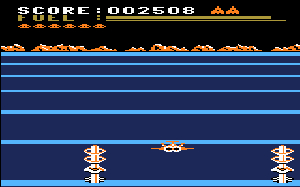 The Game: As space pilot Buck Rogers, you pilot an agile star fighter across a hazardous alien landscape, dodging buildings and destroying enemy vessels. (Sega, 1983)
The Game: As space pilot Buck Rogers, you pilot an agile star fighter across a hazardous alien landscape, dodging buildings and destroying enemy vessels. (Sega, 1983)
Memories: Bearing only the most superficial resemblance – just the design of the star fighter – to the television series of the same name, Buck Rogers: Planet of Zoom may seem like nothing terribly special these days, but at the time, it was a breakthrough in 3-D, not-quite-first-person aerial/space combat video games – from the same people who brought you Zaxxon, the first vaguely-3-D game.
Bump ‘N’ Jump
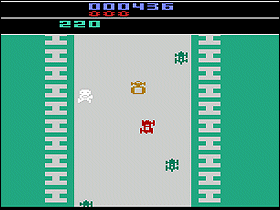 The Game: The race is on, and no moves are off-limits – bump your competitors off the road (and into apparently highly volatile vegetation that causes them to explode), or jump over them and any other obstacles that get in your way, including areas of water that cover the road. If you survive the race, you live on to the next round – at least until you run out of cars. (M Network, 1983)
The Game: The race is on, and no moves are off-limits – bump your competitors off the road (and into apparently highly volatile vegetation that causes them to explode), or jump over them and any other obstacles that get in your way, including areas of water that cover the road. If you survive the race, you live on to the next round – at least until you run out of cars. (M Network, 1983)
Memories: One of a very few arcade licenses snagged by Mattel for the Intellivision and for the M Network line of games for the Atari 2600 and other platforms, Bump ‘N’ Jump has a bumpy ride as it jumps to the relatively underpowered Atari.
Boing!
 The Game: You’re a bubble bounding around a series of platforms, changing the color of every segment on which you land. Your job is to change the color of the entire playing field while avoiding everything else, including an equally mobile needle that has a point to make. If you run into your adversaries too many times, I hate to burst your bubble, but the game’s over. (First Star Software. 1983)
The Game: You’re a bubble bounding around a series of platforms, changing the color of every segment on which you land. Your job is to change the color of the entire playing field while avoiding everything else, including an equally mobile needle that has a point to make. If you run into your adversaries too many times, I hate to burst your bubble, but the game’s over. (First Star Software. 1983)
Memories: One of the earliest entries into the video game arena by First Star Software – an outfit which is actually still in business, unlike a lot of other latecomers to the ’80s video game race – Boing! is obviously another take on the basic game play concepts of Q*Bert, and truth be told, it doesn’t bring any new innovations to the table, but it’s a slight improvement audiovisually. Boing! can also boast an easier control scheme, since it doesn’t ask the player to rotate the joystick 45 degrees. That’s a big help.
The Blobbers
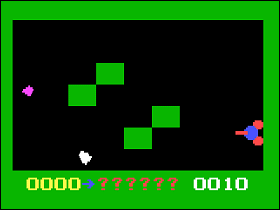 The Game: Amoeba-like monsters spawn and grow in an enclosed space with moving platforms. Players control a very mobile cannon, tasked with the mission of destroying these creatures, or at least trying to keep their population under control. The newly-spawned creatures pose no threat to the cannon – they’ll simply attach themselves to it, slowing it down unless it can shake them off. But the creatures rapidly grow in size and change colors; when a creature turns red, it is capable of destroying the cannon on contact. The cannon’s shots regress the creatures into earlier evolutionary stages; firing on a creature that has been regressed to its newly-spawned stage will destroy it. Both the cannon and the creatures can hitch a ride across the screen – either to safety or into the jaws of the enemy – aboard the platforms. (GST Video, 1983)
The Game: Amoeba-like monsters spawn and grow in an enclosed space with moving platforms. Players control a very mobile cannon, tasked with the mission of destroying these creatures, or at least trying to keep their population under control. The newly-spawned creatures pose no threat to the cannon – they’ll simply attach themselves to it, slowing it down unless it can shake them off. But the creatures rapidly grow in size and change colors; when a creature turns red, it is capable of destroying the cannon on contact. The cannon’s shots regress the creatures into earlier evolutionary stages; firing on a creature that has been regressed to its newly-spawned stage will destroy it. Both the cannon and the creatures can hitch a ride across the screen – either to safety or into the jaws of the enemy – aboard the platforms. (GST Video, 1983)
Memories: Even if this wasn’t a European-only release for the Videopac – the version of the Odyssey2 that did better in Europe than the Odyssey2 did in the Americas – The Blobbers would be hard to find. Hitting the stores at the end of the Videopac’s life span, this nifty little enclosed-space shoot-’em-up got very little attention and sold very few copies, and as such few copies made their way into the hands of game collectors and traders.
Blue Print
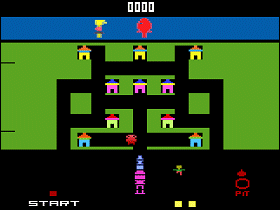 The Game: You are the intrepid, barbershop-quartet-suited J.J., out to save a damsel in distress from a pursuing monster. How does a guy in a little striped suit do this? By building a mobile, tennis-ball-launching contraption to dispatch said dastardly monster, naturally. The catch? The eight pieces of your mechanical creation are hidden somewhere among ten little houses in a maze – and those houses that don’t contain parts of your machine contain a bomb that must be dumped into the bomb pit immediately (else they’ll explode and kill J.J.). Critters also roam the maze to annoy you, including one pesky monster who will prematurely jump on the “start” button, rattling your still-unfinished machine to bits. If you don’t build your Rube Goldberg gizmo in time, the monster catches the damsel and you lose a life. (CBS Electronics, 1983)
The Game: You are the intrepid, barbershop-quartet-suited J.J., out to save a damsel in distress from a pursuing monster. How does a guy in a little striped suit do this? By building a mobile, tennis-ball-launching contraption to dispatch said dastardly monster, naturally. The catch? The eight pieces of your mechanical creation are hidden somewhere among ten little houses in a maze – and those houses that don’t contain parts of your machine contain a bomb that must be dumped into the bomb pit immediately (else they’ll explode and kill J.J.). Critters also roam the maze to annoy you, including one pesky monster who will prematurely jump on the “start” button, rattling your still-unfinished machine to bits. If you don’t build your Rube Goldberg gizmo in time, the monster catches the damsel and you lose a life. (CBS Electronics, 1983)
Memories: Sometimes arcade translations for the Atari 2600 miss the mark, and sometimes they’re right on the money. Blue Print isn’t necessarily either extreme; it’s close enough for government work.
Blue Print
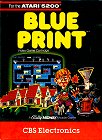 The Game: You are the intrepid, barbershop-quartet-suited J.J. (hey, it’s better than being O.J.!), out to save a damsel in distress from a pursuing monster. How does a guy in a little striped suit do this? By building a mobile, tennis-ball-launching contraption to dispatch said dastardly monster, naturally. The catch? The eight pieces of your mechanical creation are hidden somewhere among ten little houses in a maze – and those houses that don’t contain parts of your machine contain a bomb that must be dumped into the bomb pit immediately (else they’ll explode and kill J.J.). Critters also roam the maze to annoy you, including one pesky monster who will prematurely jump on the “start” button, rattling your still-unfinished machine to bits. If you don’t build your Rube Goldberg gizmo in time, the monster catches the damsel and you lose a life. (CBS Electronics, 1983)
The Game: You are the intrepid, barbershop-quartet-suited J.J. (hey, it’s better than being O.J.!), out to save a damsel in distress from a pursuing monster. How does a guy in a little striped suit do this? By building a mobile, tennis-ball-launching contraption to dispatch said dastardly monster, naturally. The catch? The eight pieces of your mechanical creation are hidden somewhere among ten little houses in a maze – and those houses that don’t contain parts of your machine contain a bomb that must be dumped into the bomb pit immediately (else they’ll explode and kill J.J.). Critters also roam the maze to annoy you, including one pesky monster who will prematurely jump on the “start” button, rattling your still-unfinished machine to bits. If you don’t build your Rube Goldberg gizmo in time, the monster catches the damsel and you lose a life. (CBS Electronics, 1983)
Memories: One of my favorite genre-crossing arcade titles, Blue Print was one of several in-house gems from Bally/Midway which were licensed under an overall deal with CBS Electronics. And while I mourn the fact that they never got around to making Kickman for the 5200, I can take come comfort in the work of art that is CBS’ home version of Blue Print.
Berzerk
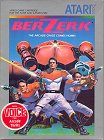 The Game: You’re alone in a maze filled with armed, hostile robots who only have one mission – to kill you. If you even so much as touch the walls, you’ll wind up dead. You’re a little bit faster than the robots, and you have human instinct on your side…but even that won’t help you when Evil Otto, a deceptively friendly and completely indestructible smiley face, appears to destroy you if you linger too long in any one part of the maze. The object of the game? Try to stay alive however long you can. (Atari, 1983)
The Game: You’re alone in a maze filled with armed, hostile robots who only have one mission – to kill you. If you even so much as touch the walls, you’ll wind up dead. You’re a little bit faster than the robots, and you have human instinct on your side…but even that won’t help you when Evil Otto, a deceptively friendly and completely indestructible smiley face, appears to destroy you if you linger too long in any one part of the maze. The object of the game? Try to stay alive however long you can. (Atari, 1983)
Memories: Already released in a near-picture-perfect version on the Atari 2600, Berzerk was surely an easy game to port to that console’s newer, more powerful sibling. But the 2600 version was so good, what could Atari do to top it?
B.C.’s Quest For Tires
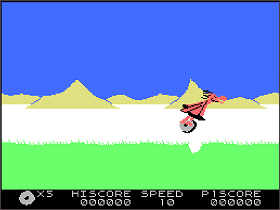 The Game: As beleaguered caveman B.C., you’ve just discovered the wheel. That’s the good news. The bad news is that, on the same day that you harness mechanical motion for the first time, you’re also going to discover the traffic accident. Jump over holes in the ground, rocks and rolling boulders, and duck under tree limbs – and then you’ve got to survive showing your new evolutionary step off to the Mrs.! (Sierra On-Line, 1983)
The Game: As beleaguered caveman B.C., you’ve just discovered the wheel. That’s the good news. The bad news is that, on the same day that you harness mechanical motion for the first time, you’re also going to discover the traffic accident. Jump over holes in the ground, rocks and rolling boulders, and duck under tree limbs – and then you’ve got to survive showing your new evolutionary step off to the Mrs.! (Sierra On-Line, 1983)
Memories: B.C.’s Quest For Tires is one of those games that immediately brings the word “Colecovision” to mind – it was a striking game for its day, and this was the platform where it truly excelled (though it was also available on several home computers as well). Johnny Hart’s comic strip wasn’t quite in the Garfield stratosphere of daily newspaper comics, but it was popular enough that its characters would seem familiar.
Balao Travesso! (“Looney Balloon!”)
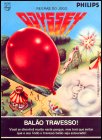 The Game: You’re piloting a balloon-toting brat around an amusement park. Ride the rides! Slide down the slide! Crawl under the trees and play! But watch out for that balloon – the thing is vital to your survival! Don’t let it get popped against the trees, or the rides, or the walls of the amusement park. Worse yet, a cloud may appear at the side of the screen and blow your balloon away, forcing you to run after it and catch it before it collides with something and pops. Birds will also fly over the park, and they can pop your balloon too. Even if you’re not holding onto it at the time, the balloon popping ends your game. (Frankly, this reliance on the balloon seems to be a bit unhealthy, and will probably lead the game’s kid to be a shut-in with another inflatable friend by the time he’s 40.) (Phillips, 1983)
The Game: You’re piloting a balloon-toting brat around an amusement park. Ride the rides! Slide down the slide! Crawl under the trees and play! But watch out for that balloon – the thing is vital to your survival! Don’t let it get popped against the trees, or the rides, or the walls of the amusement park. Worse yet, a cloud may appear at the side of the screen and blow your balloon away, forcing you to run after it and catch it before it collides with something and pops. Birds will also fly over the park, and they can pop your balloon too. Even if you’re not holding onto it at the time, the balloon popping ends your game. (Frankly, this reliance on the balloon seems to be a bit unhealthy, and will probably lead the game’s kid to be a shut-in with another inflatable friend by the time he’s 40.) (Phillips, 1983)
Memories: Released in Europe as Loony Balloon, Balao Travesso! is essentially a near-beer version of the late 70s Taito arcade game Crazy Balloon – only, quite frankly, Balao Travesso! has more elaborate graphics than the arcade game (who here thought they’d ever be reading that about an Odyssey2 game?).
Battlezone
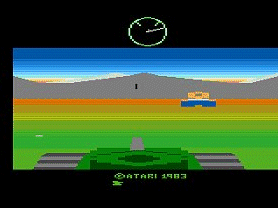 The Game: As the pilot of a heavy tank, you wander the desolate battlefield, trying to wipe out enemy tanks and landing vehicles. (Atari, 1983)
The Game: As the pilot of a heavy tank, you wander the desolate battlefield, trying to wipe out enemy tanks and landing vehicles. (Atari, 1983)
 Memories: Battlezone, in its arcade incarnation, was a huge, lumbering hulk of a beast with controls which were at best difficult to master (and at worst impossible), though it did sport some very good faux-3-D vector graphics. How on Earth was Atari going to turn this into a 2600 game?
Memories: Battlezone, in its arcade incarnation, was a huge, lumbering hulk of a beast with controls which were at best difficult to master (and at worst impossible), though it did sport some very good faux-3-D vector graphics. How on Earth was Atari going to turn this into a 2600 game?
Atlantis
 The Game: Hostile spacecraft are bombing the underwater paradise of Atlantis from above. Manning two cannons, you can knock the attacking ships out of the sky – or try to hit them at close range if they dive to bombing altitutde. When all of Atlantis’ landmarks have been wiped out, the game is over. (Imagic, 1983)
The Game: Hostile spacecraft are bombing the underwater paradise of Atlantis from above. Manning two cannons, you can knock the attacking ships out of the sky – or try to hit them at close range if they dive to bombing altitutde. When all of Atlantis’ landmarks have been wiped out, the game is over. (Imagic, 1983)
Memories: Once again, Imagic turned out a superb port of their already well-known Atari 2600 and Intellivision chestnut for the underserved Odyssey 2. Of Imagic’s two games for the Odyssey, Atlantis is the better title, though both were excellent games.
Air Raid
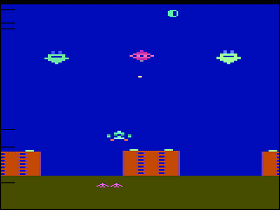 The Game: Players fly a fighter jet that can somehow maintain perfect altitude and lateral control despite constantly flying with its nose pointed straight up. Oncoming invaders, resembling UFOs, upside-down houses, upside-down stick figures (presumably the residents of the upside-down houses) and other airplanes appear; the player can either shoot them down, let them pass (with no apparent damage to the structures that the player’s jet is apparently protecting) or be blown to bits. (Men-A-Vision, 1983)
The Game: Players fly a fighter jet that can somehow maintain perfect altitude and lateral control despite constantly flying with its nose pointed straight up. Oncoming invaders, resembling UFOs, upside-down houses, upside-down stick figures (presumably the residents of the upside-down houses) and other airplanes appear; the player can either shoot them down, let them pass (with no apparent damage to the structures that the player’s jet is apparently protecting) or be blown to bits. (Men-A-Vision, 1983)
Memories: This game is not renowned for its compelling, must-hit-the-reset-switch-and-do-it-all-again game play. It’s not memorable for its searingly colorful graphics or amazing, how-did-they-get-that-sound-out-of-that-chip audio. Air Raid has none of these things. What Air Raid does have, however, is the dubious distinction of being the rarest commercially released game made for the Atari VCS, while simultaneously being one of the worst.
The Activision Decathlon
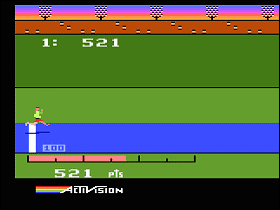
 The Game: Let the games begin! The Activision Decathlon puts players in the middle of ten summer Olympic events, each of which requires fast and furious joystick action, and careful timing on the fire button, to measure the player’s physical prowess. Events include 100 and 400 meter dashes, long jump, discus, shot put, high jump and more. (Activision, 1983)
The Game: Let the games begin! The Activision Decathlon puts players in the middle of ten summer Olympic events, each of which requires fast and furious joystick action, and careful timing on the fire button, to measure the player’s physical prowess. Events include 100 and 400 meter dashes, long jump, discus, shot put, high jump and more. (Activision, 1983)
Memories: Olympic-themed video games began to pile on pretty thick starting with Track & Field in the arcade, and Activision was ahead of the curve as well, getting The Activision Decathlon on the market a year before the 1984 games. Like Track & Field, Decathlon made use of a unique control scheme that brought some real physicality to the game, requiring players to work up at least a little bit of a sweat. It also cost many an otherwise well-constructed controller its life.
Track & Field

 The Game: It’s time for the 1984 Olympics! Qualify and compete in such events as the 100-meter dash, the long jump, javelin throw, and the shot-put. (Konami, 1983)
The Game: It’s time for the 1984 Olympics! Qualify and compete in such events as the 100-meter dash, the long jump, javelin throw, and the shot-put. (Konami, 1983)
Memories: Though the above summary of Track & Field may seem unjustly short, that really summed up the game, which was actually quite fun, especially if you could get a second player to compete against you at the same time. Very rarely have I given a sports game the time of day unless it was a good one (such as Atari’s Pole Position) or a game so goofy that it transcended its genre (i.e. the hilarious Odyssey2 Computer Golf! cartridge). Track & Field was a true rarity – a decent sports game.
Tropical Angel
 The Game: You’re a water-skiing bikini babe who’s trying to stay above water; the problem is that the water’s full of rocks that can cause you to take a painful tumble if you hit them, and the even bigger problem is that the guy driving the boat that’s pulling you along seems to have it in for you! The boat seems to be deliberately trying to pull you into harm’s way, and only fast joystick work and a sharp eye will keep you from winding up on the rocks. (IREM, 1983)
The Game: You’re a water-skiing bikini babe who’s trying to stay above water; the problem is that the water’s full of rocks that can cause you to take a painful tumble if you hit them, and the even bigger problem is that the guy driving the boat that’s pulling you along seems to have it in for you! The boat seems to be deliberately trying to pull you into harm’s way, and only fast joystick work and a sharp eye will keep you from winding up on the rocks. (IREM, 1983)
Memories: Man, whoever’s pulling that boat is just a misanthropic jerk. If you imagine that there’s a Tron-like world beyond the screen, I can only hope that the bathing-suited honey in this game finds herself a better boat driver after the game’s over.
Tapper
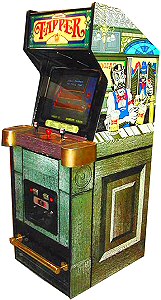
 The Game: As a beleaguered bartender, you have to serve drinks to an endless onslaught of bar patrons, never allowing them to reach the end of the bar. You must also pick up empty glasses as they slide back toward you, and you can also grab a tip whenever one briefly appears. Clearing the screen of all pixellated hardened drinkers takes you to the next screen, and other scenarios, including outdoor sporting events. (Bally/Midway, 1983)
The Game: As a beleaguered bartender, you have to serve drinks to an endless onslaught of bar patrons, never allowing them to reach the end of the bar. You must also pick up empty glasses as they slide back toward you, and you can also grab a tip whenever one briefly appears. Clearing the screen of all pixellated hardened drinkers takes you to the next screen, and other scenarios, including outdoor sporting events. (Bally/Midway, 1983)
Memories: Tapper was easily one of the most controversial games of its time. Originally conceived as a game which would be sold only to bars, it was also one of the first video game product placements for something other than a movie (i.e. Atari’s Star Wars and Bally/Midway’s own wildly successful Tron). Midway’s marketing department approached Budweiser about the possibility of sponsoring the game, in exchange for which the Bud logo would be ubiquitous on the game’s artwork and in its on-screen graphics.
Super Bagman
 The Game: As in the original Bagman, you’re a crook trying to heist all the gold out of an underground mine as a bunch of pesky cops try to catch up with you. What’s different in this sequel? You can also find a loaded gun in the subterranean caverns and take out your pursuers…but this only intensifies their determination to find you. (Stern/Seeburg [under license from Valadon Automation], 1983)
The Game: As in the original Bagman, you’re a crook trying to heist all the gold out of an underground mine as a bunch of pesky cops try to catch up with you. What’s different in this sequel? You can also find a loaded gun in the subterranean caverns and take out your pursuers…but this only intensifies their determination to find you. (Stern/Seeburg [under license from Valadon Automation], 1983)
Memories: This is an “enhancement” we didn’t need. The original Bagman is a total hoot without the gunplay. Now, I’ve played Berzerk and Robotron and Wizard Of Wor and dozens, if not hundreds, of other games in which one shoots at one’s adversaries…so why do I object to the gunplay in Super Bagman? There’s a simple reason.
Star Wars
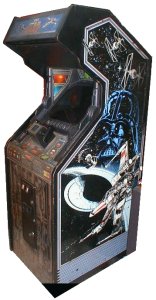
 The Game: A long time ago in a galaxy far, far away…you mean to tell me there’s someone out there who doesn’t know this story?! You’re an intrepid X-Wing pilot participating in the last-ditch Rebel attempt to destroy the Death Star – before it destroys the Rebel base on Yavin IV. TIE Fighters try to intercept you, but you can destroy them (as well as use your own lasers to blast their incoming fire out of the sky). Then you move in to attack the Death Star itself, with its incredibly hazardous system of gunnery towers and bunkers. Once you’ve gotten past the surface defenses, you dive into the trench that will lead you to an exhaust port which is the only means of destroying the Death Star – but there are defenses in the trench as well, and your deflector shields can only take so much… (Atari, 1983)
The Game: A long time ago in a galaxy far, far away…you mean to tell me there’s someone out there who doesn’t know this story?! You’re an intrepid X-Wing pilot participating in the last-ditch Rebel attempt to destroy the Death Star – before it destroys the Rebel base on Yavin IV. TIE Fighters try to intercept you, but you can destroy them (as well as use your own lasers to blast their incoming fire out of the sky). Then you move in to attack the Death Star itself, with its incredibly hazardous system of gunnery towers and bunkers. Once you’ve gotten past the surface defenses, you dive into the trench that will lead you to an exhaust port which is the only means of destroying the Death Star – but there are defenses in the trench as well, and your deflector shields can only take so much… (Atari, 1983)
Memories: In a sad way, Atari’s uber-Star Wars game puts Sega’s rival Star Trek arcade game in its grave. The eminently playable and addictive Star Wars is fast-moving, gut-wrenching, and best yet, you actually have at least a chance of winning the game, offering some satisfaction that you’d accomplished something.
Sinistar
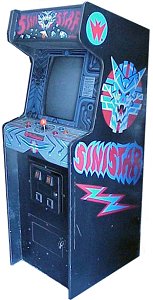
 The Game: In a lone space fighter, you’re on the most dangerous space combat mission this side of Luke Skywalker. While evading or destroying drone robots and gunships in a hazardous asteroid field, you’re trying to mine the raw materials needed for Sinibombs, your only defense against the huge, terrifying space station, Sinistar. You can bomb the components of Sinistar as they are being put in place, but as a last resort, your Sinibombs can damage it in its complete form as well. If you should happen to find yourself within range of the fully-operational Sinistar without the armament needed to protect yourself, there are snowballs in hell that stand a better chance of surviving than you do. (Williams Electronics, 1983)
The Game: In a lone space fighter, you’re on the most dangerous space combat mission this side of Luke Skywalker. While evading or destroying drone robots and gunships in a hazardous asteroid field, you’re trying to mine the raw materials needed for Sinibombs, your only defense against the huge, terrifying space station, Sinistar. You can bomb the components of Sinistar as they are being put in place, but as a last resort, your Sinibombs can damage it in its complete form as well. If you should happen to find yourself within range of the fully-operational Sinistar without the armament needed to protect yourself, there are snowballs in hell that stand a better chance of surviving than you do. (Williams Electronics, 1983)
Memories: A truly intimidating and challenging game, Sinistar‘s only drawback is a slightly aggravating control system; since it doesn’t quite adhere to the physical rules of bodies, motion and inertia that were so interestingly utilized in such games as Asteroids, Sinistar is a bit more difficult to get a handle on.
Q*Bert’s Qubes
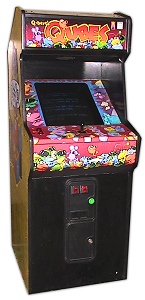 The Game: Q*Bert is back, hopping around from cube to cube, rotating the cubes 90 degrees with every hop…but a nasty bouncing rat and his minions are out to get the big Q. If one of the rat’s henchmen hops onto a cube whose top surface is the same color as its skin, it melts into the cube harmlessly. Q*Bert must change at least one row of cubes to the target color to advance to the next level – and there aren’t any flying discs this time! (Mylstar Electronics, 1983)
The Game: Q*Bert is back, hopping around from cube to cube, rotating the cubes 90 degrees with every hop…but a nasty bouncing rat and his minions are out to get the big Q. If one of the rat’s henchmen hops onto a cube whose top surface is the same color as its skin, it melts into the cube harmlessly. Q*Bert must change at least one row of cubes to the target color to advance to the next level – and there aren’t any flying discs this time! (Mylstar Electronics, 1983)
Memories: Similar enough that veteran Q*Bert players could pick up its play mechanics in their first game, but different enough to throw them off their game, Q*Bert’s Qubes was a textbook example of a good arcade sequel. It certainly didn’t hurt that it introduced a whole new pantheon of cute adversaries for Q*Bert to avoid, and yet somehow, the only thing anyone really seems to remember about any iteration of Q*Bert’s Qubes is how scarce it was – and still is.
Professor Pac-Man
 The Game: The denizens of Pac-Land must surely know how to do something other than just devour dots and munch monsters. And they learn from Professor Pac-Man himself, the dean of dot-gobblers. Professor Pac-Man poses questions of all kinds to you (and an opponent, if you have a second player), including visual recognition tests and matching puzzles. A Pac-Man gobbles a row of dots from left to right, counting down the seconds you have to correctly answer the question. Correct answers gain points and fruit, while incorrect answers will cost you. Lose more points than you have to spare, and the game’s over. (Bally/Midway, 1983)
The Game: The denizens of Pac-Land must surely know how to do something other than just devour dots and munch monsters. And they learn from Professor Pac-Man himself, the dean of dot-gobblers. Professor Pac-Man poses questions of all kinds to you (and an opponent, if you have a second player), including visual recognition tests and matching puzzles. A Pac-Man gobbles a row of dots from left to right, counting down the seconds you have to correctly answer the question. Correct answers gain points and fruit, while incorrect answers will cost you. Lose more points than you have to spare, and the game’s over. (Bally/Midway, 1983)
Memories: This is one of those games where you can just picture someone in the marketing department saying “How can we exploit the Pac-Man license from Namco in a way that’s never been done before?” Video trivia games were nothing new, but the  talent assembled to produce Professor Pac-Man was appropriately prodigious. Marc Canter and Mark Pierce, both Midway staffers, went on to form their own company in 1984 called MacroMind; a few changes in direction and a few strategic mergers later, MacroMind became none other than creativity software powerhouse Macromedia, and Canter and Pierce, along with longtime Midway veteran Jamie (Gorf designer and Bally Astrocade console creator) Fenton, had a hit on their hands with a little software package called Director. You may have heard of it. Just about anyone who has ever slapped a Flash animation onto the web certainly has.
talent assembled to produce Professor Pac-Man was appropriately prodigious. Marc Canter and Mark Pierce, both Midway staffers, went on to form their own company in 1984 called MacroMind; a few changes in direction and a few strategic mergers later, MacroMind became none other than creativity software powerhouse Macromedia, and Canter and Pierce, along with longtime Midway veteran Jamie (Gorf designer and Bally Astrocade console creator) Fenton, had a hit on their hands with a little software package called Director. You may have heard of it. Just about anyone who has ever slapped a Flash animation onto the web certainly has.
Popeye
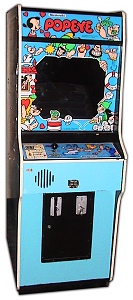 The Game: Well, blow me down! Popeye the sailor man gets his own video game. On level one, you’re trying to catch Olive Oyl’s falling hearts before they descend to sea level and are lost, while ducking Bluto’s punches at the same time. A can of spinach appears every so often, giving you the opportunity to read the big bully the riot act (comic strip-style, of course). On level two, the falling hearts are replaced by falling musical notes, and you’ll need Wimpy’s hefty help to keep Swee’Pea from drifting away on a balloon. (Nintendo, 1983)
The Game: Well, blow me down! Popeye the sailor man gets his own video game. On level one, you’re trying to catch Olive Oyl’s falling hearts before they descend to sea level and are lost, while ducking Bluto’s punches at the same time. A can of spinach appears every so often, giving you the opportunity to read the big bully the riot act (comic strip-style, of course). On level two, the falling hearts are replaced by falling musical notes, and you’ll need Wimpy’s hefty help to keep Swee’Pea from drifting away on a balloon. (Nintendo, 1983)
Memories: A true licensing coup for relative newcomers Nintendo, this project hooked them up with the cartoon marketing savvy of King Features Syndicate (and don’t think for a moment that Nintendo didn’t soak up as much knowledge as it could to put to use on its next hot property, Mario Bros.) But even though it’s a well-loved and remembered game, it wasn’t Popeye’s first arcade outing.
Pole Position II
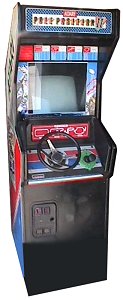 The Game: So, you survived the qualifying lap and the big race in Pole Position and you’re ready to move on to bigger and better challenges? Well okay then. Now, in addition to the Fuji track, there are others to choose from –
The Game: So, you survived the qualifying lap and the big race in Pole Position and you’re ready to move on to bigger and better challenges? Well okay then. Now, in addition to the Fuji track, there are others to choose from –  the simple oval of the Test track, and the elaborate (and sometimes deadly) curves of the Seaside and Wonder tracks. As before, going over the shoulder isn’t a good thing – nor is crawling up the tailpipe of the cars in front of you, for the explosions in this game are even more spectacular than those of its predecessor. (Atari [under license from Namco], 1983)
the simple oval of the Test track, and the elaborate (and sometimes deadly) curves of the Seaside and Wonder tracks. As before, going over the shoulder isn’t a good thing – nor is crawling up the tailpipe of the cars in front of you, for the explosions in this game are even more spectacular than those of its predecessor. (Atari [under license from Namco], 1983)
Memories: Namco knows a thing or two about decent sequels, having given us such classics as Galaga (the sequel to Galaxian), Dig Dug 2 and the obscure Hopping Mappy. Pole Position II‘s controls are even more responsive, the graphics more fluid and realistic, and the explosions? Well, let’s put it this way – Pole Position kills you with a nice big explosion. Pole Position II throws debris.
Phozon
 The Game: You control a “Chemic,” a free-floating object while can adhese itself to passing Moleks, but is vulnerable to the Atomic. Within a limited amount of time (charted by a meter at the bottom of the screen), gather and repulse Moleks around your Chemic until you’ve duplicated the example shape shown in the center of
The Game: You control a “Chemic,” a free-floating object while can adhese itself to passing Moleks, but is vulnerable to the Atomic. Within a limited amount of time (charted by a meter at the bottom of the screen), gather and repulse Moleks around your Chemic until you’ve duplicated the example shape shown in the center of  the screen. Beware of the Atomic, however – it will not only become more aggressive in its deceptively aimless wanderings, but it can also separate into its own component molecules – and regather its shape right in your path. It also shoots, in later levels, energy that can dislodge Moleks from the Chemic’s pattern. You advance through the game by successfully duplicating the sample shape – and surviving the Atomic’s attacks. (Namco, 1983)
the screen. Beware of the Atomic, however – it will not only become more aggressive in its deceptively aimless wanderings, but it can also separate into its own component molecules – and regather its shape right in your path. It also shoots, in later levels, energy that can dislodge Moleks from the Chemic’s pattern. You advance through the game by successfully duplicating the sample shape – and surviving the Atomic’s attacks. (Namco, 1983)
Memories: If someone pinned me up against the wall and demanded that I name my favorite coin-op manufacturer – and I’ll admit that this isn’t terribly likely to happen – I’d have to say Namco. They brought us such immortal and inexplicably (and insanely) fun games as Pac-Man, Mappy, Dig Dug, Galaga, Motos, Pole Position and Warp Warp – to name just a few. Among these popular titles are games so indescribably weird that they almost defy description, but I have to hand Namco the prize for sheer conceptual brilliance. Phozon, more obscure than any of the games mentioned above (even moreso than Motos, which is pretty esoteric itself), may well be the first video game ever to concern itself with molecular bonding.
Pac ‘N’ Pal
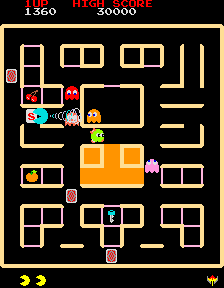 The Game: Once again, you are a round yellow creature consisting of a mouth and nothing else, maneuvering around a relatively simple maze. But this time, you have a Pal! A little round green Pal who is here just to help you. (Pal appears to be wearing a little bow, so there’s no indication of whether or not Ms. Pac-Man knows about
The Game: Once again, you are a round yellow creature consisting of a mouth and nothing else, maneuvering around a relatively simple maze. But this time, you have a Pal! A little round green Pal who is here just to help you. (Pal appears to be wearing a little bow, so there’s no indication of whether or not Ms. Pac-Man knows about  Pac-Man’s pal…) Those four pesky monsters are back. This time, the handful of treats in each maze is locked away behind doors vaguely reminiscent of Super Pac-Man. These doors can be unlocked by munching one of the cards lying around the maze. Fruit will score points for you, but if you eat one of the two Galaxians in each maze, Pac-Man is briefly imbued with a super shout which stuns the monsters for a little while. The only problem? Pac’s Pal will grab the fruit or the Galaxians and…very slowly…get around to bringing it to him. Sometimes this helps – Pal is impervious to the monsters, and there are no power pellets to help Pac-Man this time – but sometimes Pal dimwittedly marches your much-needed Galaxian right into the middle of the monsters, making it inaccessible. (Bally/Midway, 1983)
Pac-Man’s pal…) Those four pesky monsters are back. This time, the handful of treats in each maze is locked away behind doors vaguely reminiscent of Super Pac-Man. These doors can be unlocked by munching one of the cards lying around the maze. Fruit will score points for you, but if you eat one of the two Galaxians in each maze, Pac-Man is briefly imbued with a super shout which stuns the monsters for a little while. The only problem? Pac’s Pal will grab the fruit or the Galaxians and…very slowly…get around to bringing it to him. Sometimes this helps – Pal is impervious to the monsters, and there are no power pellets to help Pac-Man this time – but sometimes Pal dimwittedly marches your much-needed Galaxian right into the middle of the monsters, making it inaccessible. (Bally/Midway, 1983)
Memories: Possibly the most bizarre entry in the Pac-Man series, this game is a little bit confusing…and is, perhaps, the final indication that Bally/Midway and Namco had gone to the Pac-Man well one too many times. By this time, the only resemblance the latest Pac-game bore to the original were the elements of Pac-Man, the monsters, and the maze. And don’t even ask where Pal came from. I haven’t a clue.
Mr. Do!’s Castle
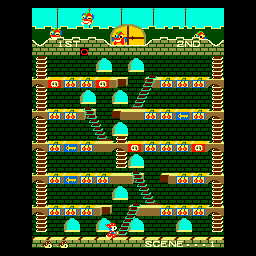 The Game: As cuddly clown Mr. Do, you’re scrambling to squish all the unicorns who are invading your castle. You can repel them momentarily with your clown hammer, but you can only squish them permanently by knocking a brick out from the floor above. Most bricks contain cherries, but some also contain keys that unlock the door at the top. When that door is completely unlocked, touching it will transform the unicorns into letters that make up the word EXTRA. As with Mr. Do!, collecting all five letters merits an extra “life.” Clearing the screen of monsters or cherries advances you to the next level. (Universal, 1983)
The Game: As cuddly clown Mr. Do, you’re scrambling to squish all the unicorns who are invading your castle. You can repel them momentarily with your clown hammer, but you can only squish them permanently by knocking a brick out from the floor above. Most bricks contain cherries, but some also contain keys that unlock the door at the top. When that door is completely unlocked, touching it will transform the unicorns into letters that make up the word EXTRA. As with Mr. Do!, collecting all five letters merits an extra “life.” Clearing the screen of monsters or cherries advances you to the next level. (Universal, 1983)
Memories: Another of my favorite obscure games, Mr. Do!’s Castle is truly cool, fun and addictive – all the requisite qualities of a good video game. In my mind, it easily outshines the original Mr. Do! by miles, and is one of the most unique and original entries in the ladders-and-levels genre since Donkey Kong.